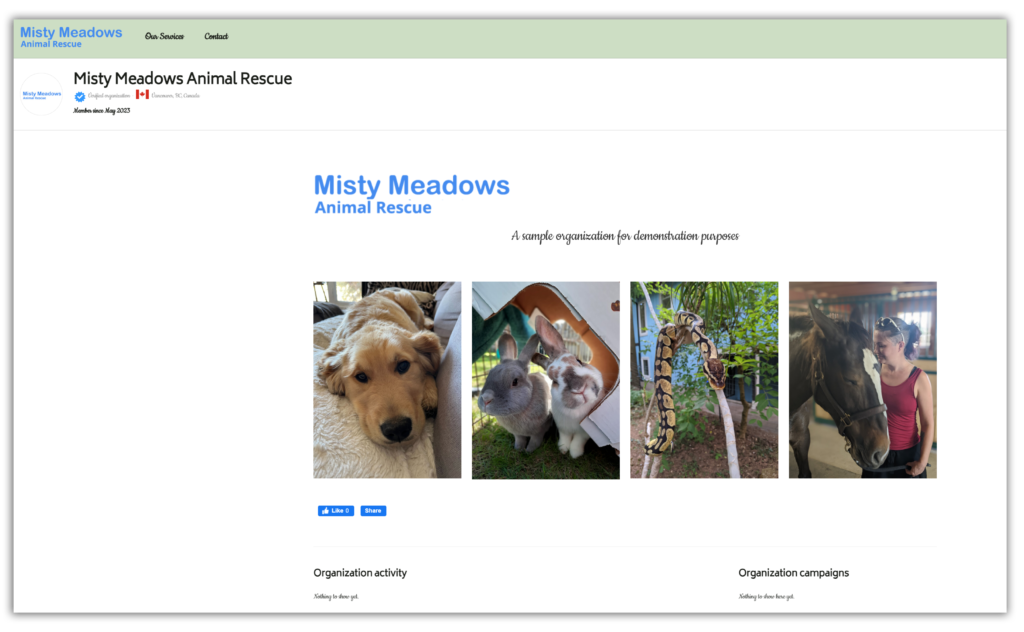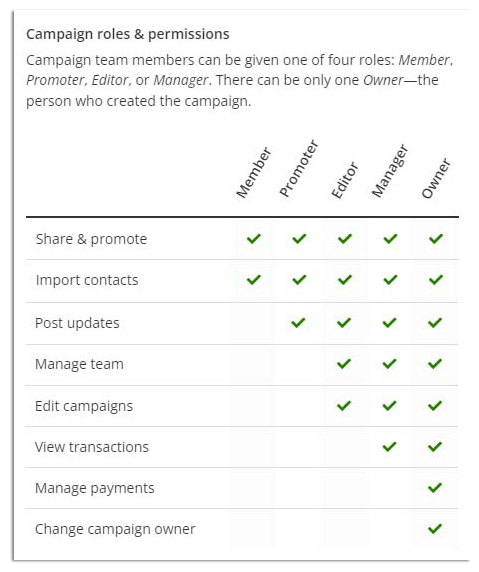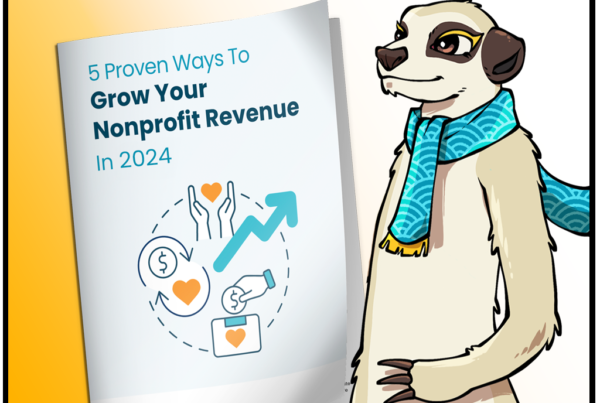For non-profits, charities, and businesses raising funds for a cause (animal or otherwise!): learn how to create a professional digital fundraising profile for your organization on FundRazr & PetFundr.
*Updated August 2023*
FundRazr and PetFundr provide organizations of all kinds (whether non-profit, business, just-starting-out, well-established, one hardcore worker or multi-national giant) with multiple extended features that personal campaigns don’t have access to.
Learn how to make the most of these features and increase your campaign contributions with this comprehensive toolkit, full of practical tips and a free workbook to help get you started.
Includes:
- How-to instructions on customizing the organization profile;
- Descriptions of the layouts available for organizations only;
- Managing reward fulfillment;
- Digital fundraising and live events;
- How to manage multiple campaigns.
Customizing your professional fundraising profile
We’ll begin with your organization profile, so if you have not created one yet, begin here with FundRazr or here with PetFundr.
Theme
As much as we love our brands and our logos, the platforms are designed for organizations to showcase their own brand. Customizing your theme replaces FundRazr’s logo in the header and lets you change the header colour and font to match your website’s branding. You may also customize your campaign fonts, button colours, add navigation links, and more.
To customize your theme, you’ll need:
- Logo in PNG format (this is the only mandatory section)
- Brand RBG or HEX colour codes
- Website homepage and desired navigation links (‘About’ and ‘Contact’ links are recommended)
- Copyright message (tip: if you have one on your current website, simply copy & paste)
- Brand fonts (note: FundRazr uses Google Fonts; if your font does not appear, do a quick web search for a similar Google Font)
Customize some basic design details in your profile’s theme menu to match your branding. This helps with a smoother transition between your website and the platform.
Set the theme from the “Theme” option in your sidebar menu – select ‘yes’ to a custom theme for the options to appear, and make your changes. Don’t forget to hit ‘Save!’


Writing about your organization for professional fundraising
Your organization profile should contain information your supporters will want to know. It’s helpful to sketch out key points first, so in our workbook, we’ve included a sheet to write out key points for each of the following suggestions:
- A welcome message
- Introduction to who your organization is and where you’re located
- Your mission statement, guiding values, and/or company motto
- Who does your organization support? As in, who are the beneficiaries of the funds you raise, and how do you support them?
- What else would you like your supporters to know?
Professional fundraising campaign layouts
FundRazr and PetFundr offer multiple layout options for organizations, including multi-tiered campaigns. These are two-tiered campaigns with as many sub-campaigns as you need – all with goals and funds adding up into a main campaign.
Here are the current layout options:
- Donation form – create a link from your website/social media directly to this form to facilitate spontaneous donations or recurring donation programs
- Peer-to-peer (multi-tier) – host an event (live or virtual) that your supporters can register to and fundraise using their own sub-campaign, with funds going directly to your organization
- Do-it-yourself (multi-tier) – allow supporters to choose how they’ll fundraise for your organization
- Microprojects (multi-tier) – break down large goals and projects into smaller ones for higher chances of success
- Storefront – showcase swag or other items that contributors can receive in exchange for their donations, OR create a store of wishlist items your organization regularly needs
Donation forms for professional fundraising
The most common question for donor forms is how many and what contribution amounts to pre-populate as suggestions for supporters. Supporters can always customize their contribution to whatever they like – however, there is psychology around what amounts you should show as suggestions.
There are two factors to consider when choosing contribution levels for the form:
- What is your average contribution?
- Choose your default contribution amounts around this range
- What do your funds generally go toward?
- You can create ‘descriptive’ suggestions for contribution amounts that provide the emotional appeal that makes campaigns successful.
Default contribution amounts

Default amounts appear directly on the donation form, with the preselected amount in green. You can choose to use your average contribution (if you know it) alongside the low- and high-end amounts to create a range or increase them by 10% to try to encourage greater support. We recommend having 4 to 5 pre-populated options for contributions.
For example, say your organization’s average contribution is $65, with a low end of $15 and a high end of $500. Since our average contribution is nearer to the low end of our contribution range, we worked around that to arrive at the final default contribution amounts as listed above: $15, $30, $65, and $100. ‘Other’ remains available for those wishing to enter something different.
Descriptive amounts
Descriptive amounts are great tools for showcasing your units of impact, which help communicate the emotional impact of a campaign story. Describe actual physical items, experiences, or the impact of the contribution on the beneficiary. Time to get creative!
Example – animal shelter
$15 – Give a shelter dog an enrichment toy.
$30 – This is the cost of a grooming session for a street pup to look adoption-ready.
$65 – High-quality food for one dog for one month
$100 – Gift a training session for some of our dogs who need to learn some manners before they find their forever home!
Pro tip: Click ‘Prompt for unrestricted usage of funds ‘ in your Data collection menu to communicate with your supporters that funds will be applied to where they are needed most and remove their restricted use.
Our workbook below has a sheet for you to try your own descriptive amounts out!
Peer-to-peer professional fundraising
Utilize your supporters and their communities to reach high goals and increase your donor base! Peer-to-peer fundraising is becoming increasingly popular, with virtual and hybrid events on the rise after the COVID pandemic prevented in-person events.
Fundraising teams and/or individuals get their own sub-campaign to run, with all funds deposited directly to your organization. Planning is paramount, even in virtual events. We even have a full toolkit surrounding peer-to-peer fundraising, so we’ll include the fundamentals here.
| Choose an event date | Fundraisers need at least a month to fundraise, and you will need 4-8 weeks to recruit fundraisers. Plan well in advance! |
| Will the event be live, virtual, or a hybrid? | In a post-pandemic world, more organizations are providing virtual options for fundraising events. Have fundraisers participate via video chat, or – for races or other events with physical activity – they can participate solo wherever they are. |
| What is your date to open recruitment for fundraising? | Will the event be live, virtual, or hybrid? |
| What will the event be? | We’ve seen the classic races (walk, run, bike, etc.), hot-sauce eating, rappelling off buildings, etc. |
| What is the overall campaign goal? | Please refer to our Campaign Guide for how to choose a goal. |
| Will you allow individuals, teams, or both to participate? | Both are recommended! |
| Team member goal | This is your recommended amount for how much EACH fundraiser will raise, regardless if they are on a team. |
| Registration fee | Registration fees aren’t mandatory but are encouraged to ensure commitment. |
Refer to the workbook below to plan out a potential peer-to-peer fundraiser for your organization.
Do-it-yourself (DIY)
Let your supporters choose how to help you! DIY campaigns work much the same way as peer-to-peer, with a couple of subtle differences:
- Sub-campaigns show in a grid pattern that is continually randomized, so there is no competition factor
- Usually not associated with one specific event (although it can if you wish). Instead, fundraisers register their campaign under your organization and choose their own goal, deadline, and how they’ll get the funds.
An example of common DIY campaigns is birthday fundraisers: rather than receiving gifts, the fundraiser encourages contributions to your cause for their birthday.
Brainstorm DIY campaign ideas in your workbook.
Microprojects™
Microprojects™ take large monetary goals and break them down into smaller, more easily obtainable goals while protecting the story’s integrity.
For an in-depth description of Microprojects™, including examples, check out this article on the HUB blog page.
There are two types of Microprojects: Grid and Leaderboard. Which you use depends on if it makes more sense to have a competitive component or not. With the Leaderboard, your sub-campaigns list in order from most-to-least funds raised. With the Grid, widgets for the sub-campaigns are placed in the main campaign in random order.
Have a large project you might be able to break down? Plan them out in your workbook below! Make sure to examine the examples provided in our Microproject blog post to jumpstart your creativity!
Stores
FundRazr and PetFundr allow organizations to build and maintain storefronts. If you have merchandise OR wishlist items that are consistently available/in need, this may be a viable option. Two templates exist for stores:
| Social Storefront | Simple Storefront |
|---|---|
| Picture/video gallery and social sharing bar are included. No stats (goal, deadline, amount raised, # of supporters) appear. Good for when the majority of supporters will reach this page via shared links from social media, emails, etc. | No media gallery or social sharing bar. No stats (goal, deadline, amount raised, # of supporters) appear. No media gallery, but pictures and/or videos (videos from YouTube or Vimeo only) may still be embedded in the ‘Story’ section. Good for a smooth transition between your website and campaign (via link or widget) |
Reward Fulfillment for Professional Fundraising
If collecting, managing, and fulfilling reward items like perks and products is something you’d like to try for your organization but aren’t sure where to start, we’ve done our best to make life a bit easier for you. All of this work whether you’ve chosen a storefront layout (as described above) or not!
Find all orders from your supporters in the ‘Order items’ section on the Transaction page or the sidebar menu. You can download this information in two ways:
- In a line-by-line list – good for gathering totals of each reward type for printing/manufacturing.
- Separated by order – see which rewards were ordered together; good for your boxing/shipping prep.

Fulfillment and communication
As with all aspects of crowdfunding, communicating with your supporters is key. Here is a list of items to make sure you effectively communicate to all supporters before and after they’ve contributed:
- Which countries will you ship to? What are the estimated delivery times for each country you’re shipping to?
- How will large orders be handled? Will there be discounted shipping rates?
- How will returns be handled? Will the supporter be charged a return fee?
- All-Or-Nothing campaigns: how long after the campaign deadline do you expect manufacturing/printing/production to take?
- Keep-It-All campaigns: are you shipping on demand or in batches?
- Delays: communicate delays with as much information as you can, as soon as you can. Delays are sometimes unavoidable (manufacturing issues, shipping obstacles, weather, pandemics…), but an informed supporter is a happy supporter.
Professional fundraising for live events
Have you thought about a live fundraising event but were afraid a lack of turnout would put you too far in the red?
How about crowdfunding your tickets? Tickets are a reward item – Create an All-or-nothing campaign with tickets as the reward and use that assurance that you will have the attendance you need to go ahead.
Most venues require pricing for certain amounts of guests, so we’ve created a table in the workbook below to budget for your event, plan out ticket costs and attendee numbers needed, etc. Alter as needed!
If you’re curious about how our tickets work, this article explains everything.
Managing multiple campaigns for professional fundraising
Planning worksheet
As an organization, you have the ability to run as many different campaigns (in any type or layout) as you’d like. The art of managing multiple crowdfunding campaigns at once comes down to two things: planning and delegating.
Strategizing for each campaign is still necessary, and you can find help for this in our FundRazr Campaign Toolkit.
However, planning is also fundamental for making sure no ball is dropped on any part of the campaign cluster your organization is managing. To help with this, we’ve created a spreadsheet that you may use as-is or alter to fit your needs:
Multiple Campaign Management Worksheet (Note: there are two tabs to this spreadsheet)
Pro Tip: you can assign team members tasks directly on FundRazr through the Task Centre!
Campaign teams
Each campaign can have a different team assigned to it. These team members can show prominently in the public view, which is perfect when more than one collaborator is involved with a project. There are multiple roles to choose from for each team member, depending on what permissions you would like to allow them.

NOTE: Each campaign can have only one Owner but multiple Managers, Editors, Promoters, and Members.
Campaign checklist
With new campaigns starting throughout the year, it becomes easy to miss key steps in their creation. Also, if you have multiple teammates assisting, you may want to maintain some consistency across campaigns. We’ve created a checklist you can use to help you with efficient campaign creation; use it yourself, or pass it along to your team. Don’t forget to add in any items your organization specifically needs.
Click to download the campaign checklist
Workbook & other worksheets
Organization Workbook:
Spreadsheet: Managing multiple campaigns
Campaign checklist for organizations




